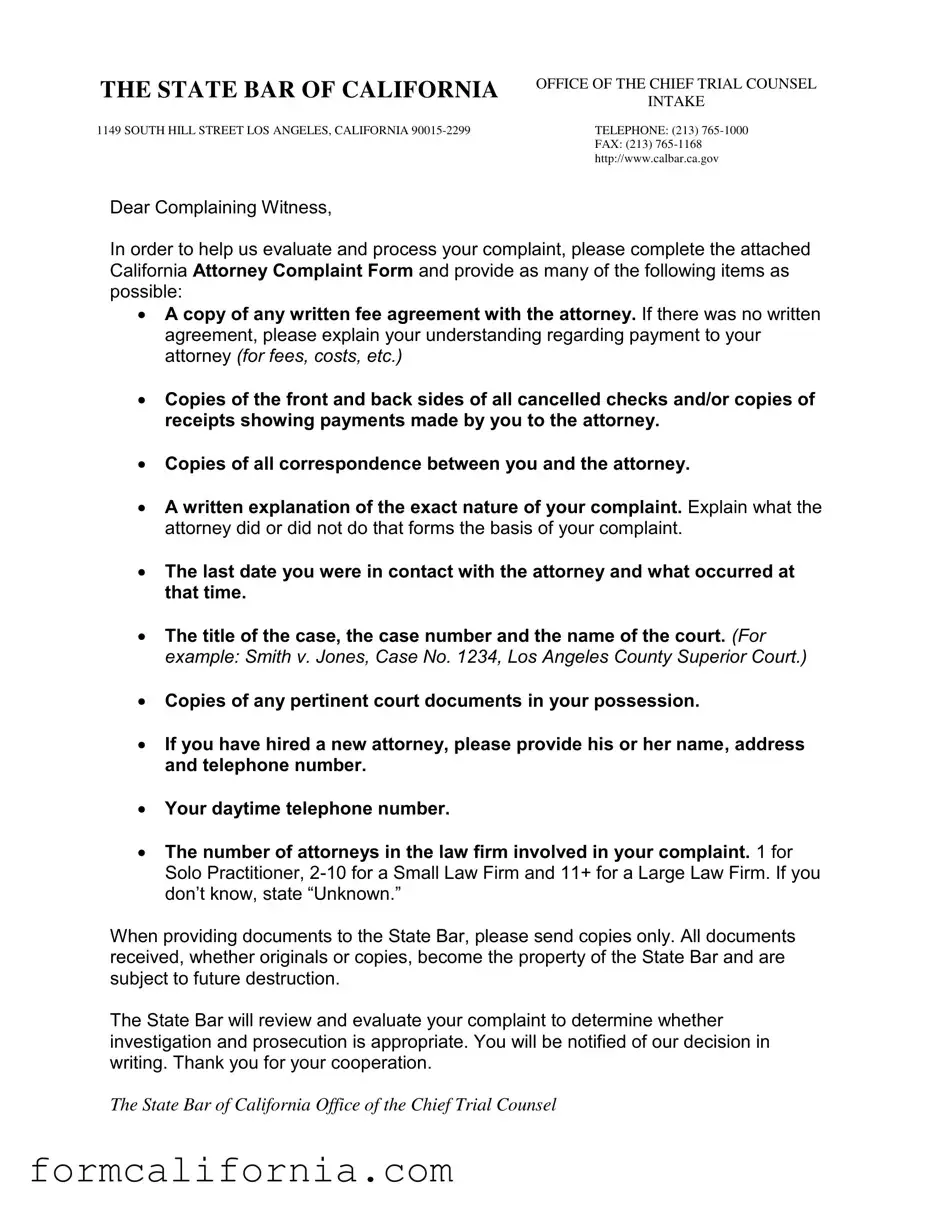THE STATE BAR OF CALIFORNIA |
OFFICE OF THE CHIEF TRIAL COUNSEL |
|
INTAKE |
1149 SOUTH HILL STREET LOS ANGELES, CALIFORNIA 90015-2299 |
TELEPHONE: (213) 765-1000 |
|
FAX: (213) 765-1168 |
|
http://www.calbar.ca.gov |
Dear Complaining Witness,
In order to help us evaluate and process your complaint, please complete the attached California Attorney Complaint Form and provide as many of the following items as possible:
·A copy of any written fee agreement with the attorney. If there was no written agreement, please explain your understanding regarding payment to your attorney (for fees, costs, etc.)
·Copies of the front and back sides of all cancelled checks and/or copies of receipts showing payments made by you to the attorney.
·Copies of all correspondence between you and the attorney.
·A written explanation of the exact nature of your complaint. Explain what the attorney did or did not do that forms the basis of your complaint.
·The last date you were in contact with the attorney and what occurred at that time.
·The title of the case, the case number and the name of the court. (For example: Smith v. Jones, Case No. 1234, Los Angeles County Superior Court.)
·Copies of any pertinent court documents in your possession.
·If you have hired a new attorney, please provide his or her name, address and telephone number.
·Your daytime telephone number.
·The number of attorneys in the law firm involved in your complaint. 1 for
Solo Practitioner, 2-10 for a Small Law Firm and 11+ for a Large Law Firm. If you don’t know, state “Unknown.”
When providing documents to the State Bar, please send copies only. All documents received, whether originals or copies, become the property of the State Bar and are subject to future destruction.
The State Bar will review and evaluate your complaint to determine whether investigation and prosecution is appropriate. You will be notified of our decision in writing. Thank you for your cooperation.
THE STATE BAR OF CALIFORNIA OFFICE OF THE CHIEF TRIAL COUNSEL
THE STATE BAR OF CALIFORNIA
Instructions for Filing a Complaint Against a California Attorney
Fill out all spaces on the California Attorney Complaint Form completely. Provide your name, address, zip code and telephone numbers (work and home).
Please mail, do not fax, your complaint form to the Office of the Chief Trial Counsel/Intake, State Bar of California, 1149 South Hill Street, Los Angeles, California 90015-2299.
Be sure to give the full and complete name of the attorney you are complaining about. Also, provide his address and telephone number. If you wish to complain about more than one attorney, use a separate form for each attorney. If any of the blank spaces do not apply to your case, write N/A (Not Applicable). Be sure to date and sign the form.
Please note #7 on the form and answer if known. If you do not know, state “Unknown.”
On a separate sheet of paper, tell us about your complaint against the attorney. We also need to know the background of your case:
·What type of case is it?
·When did you hire the attorney?
·How did you choose the attorney?
·When did you meet the attorney?
·What was your agreement?
·Was the agreement verbal or in writing?
·Other pertinent information?
·Tell us in your own words what has happened so far in this case.
Some Things You Should Know
The Office of the Chief Trial Counsel (OCTC) reviews complaints of unethical conduct by attorneys licensed to practice in California. Should OCTC prosecute allegations contained in your complaint, you may be required to testify before the State Bar Court in order to prove charges against the attorney(s) involved. Below is a list of what the State Bar can and cannot do when it considers a complaint against an attorney:
·The State Bar can discipline or recommend that an attorney be disciplined only for a violation of the State Bar Act or the Rules of Professional Conduct.
·The State Bar cannot advise or otherwise help you in any matters connected with
your complaint or in any other dispute in which you may be involved. For example, it cannot decide whether an attorney’s particular fee is reasonable. Attorney fees are not reimbursable simply because you are dissatisfied with the services of your attorney or because the work was not completed. Some local
Bar Associations have a Fee Arbitration Committee. The State Bar’s Fee Arbitration program is available should your local bar association not provide fee arbitration. Attorneys are required to participate in fee arbitration initiated by their clients, and fee arbitration is an informal, confidential and lower cost forum for resolving fee disputes between lawyers and their clients.
·The State Bar cannot give you the name of a particular attorney to help you. If
you do not have an attorney and wish to hire one, contact a Lawyer Referral Service in your area. The State Bar pamphlet “How Can I Find & Hire the Right Lawyer” is available on the State Bar’s Web site, www.calbar.ca.gov (go to
Consumer Pamphlets).
·The law limits the authority of the State Bar. It cannot act as your lawyer. For example, it cannot give you legal advice, or perform any other legal services for you (such as pursuing damages or other legal action against the attorney(s) involved in your complaint). You may have legal remedies available to you but the State Bar cannot advise you what your rights are in a given situation or what you should do. The State Bar is not a court that can provide civil remedies to you.
·If the State Bar files charges in the State Bar Court and obtains an order of discipline, additional remedies such as restitution also may be ordered. In addition, the State Bar has a Client Security Fund (CSF), which reimburses specific monetary loss. Reimbursement covers the loss of money or property resulting from lawyer dishonesty (but not simply because the lawyer acted incompetently, committed malpractice or failed to take certain actions). To qualify for CSF reimbursement, you must be able to show that the money or property actually came into the lawyer's possession and that the loss was caused by the lawyer's dishonest conduct. For example, the types of dishonest conduct that may lead to reimbursement from CSF are theft or embezzlement, failure to refund advanced attorney fees where the lawyer performed no services, the borrowing of money from a client without intention to repay the money, obtaining money or property from a client by representing that it would be used for investment purposes when no investment is made, and an act of intentional
dishonesty or deceit that directly leads to the loss of money or property that actually came into the lawyer’s possession. CSF cannot process applications for reimbursement until final discipline has been ordered against the attorney by the California Supreme Court.
THE STATE BAR OF CALIFORNIA
CALIFORNIA ATTORNEY COMPLAINT FORM
Read instructions before filling in this form.
Date:
(1)Your contact information: Your name:
Your address:
Your city, state & zip code: Your email address:
Your telephone numbers: |
|
|
Home |
Work |
Cell |
(2)Attorney’s contact information: Please provide the name, address and telephone
number of the attorney(s) you are complaining about. (NOTE: If you are complaining about more than one attorney, include the information requested in items #2 through #7 for each attorney. Use separate sheets if necessary.
Attorney’s name:
Attorney’s address:
Attorney’s city, state & zip code:
Attorney’s telephone number:
(3)Have you or a member of your family complained about this attorney(s) previously?
If “Yes”, please state to whom the previous complaint was made, approximate date of complaint and disposition.
(4) Did you employ the attorney? Yes |
No |
If “Yes,” give the approximate date you employed the attorney(s) and the amount, if any, paid to the attorney(s).
Date employed: |
|
Amount paid (if any): $ |
|
|
|
If “No,” what is your connection with the attorney(s)? Explain briefly.

(5)Include with this form (on a separate piece of paper) a statement of what the attorney(s) did or did not do which is the basis of your complaint. Please state the facts as you understand them. Do not include opinions or arguments. If you employed the attorney(s), state what you employed the attorney(s) to do. Sign and date each separate piece of paper. Additional information may be requested. (Attach copies of pertinent documents such as a copy of the fee agreement, cancelled checks or receipts and relevant correspondence.)
(6)If your complaint is about a lawsuit, answer the following, if known:
a.Name of court (For example, Superior or Municipal Court, and name of the county)
b.Title of the suit (For example, Smith v. Jones)
c.Case number of the suit 
d. Approximate date the suit was filed
e. If you are not a party to this suit, what is your connection with it? Explain briefly.
(7)Size of law firm complained about:

 1 Attorney
1 Attorney
 2 – 10 Attorneys
2 – 10 Attorneys

 11 + Attorneys
11 + Attorneys

 Government Attorney
Government Attorney

 Unknown
Unknown
Mail to:
Office of the Chief Trial Counsel/Intake
The State Bar of California
1149 South Hill Street
Los Angeles, California 90015-2299
Signature _____________________________________________________





 1 Attorney
1 Attorney

 11 + Attorneys
11 + Attorneys
 Government Attorney
Government Attorney
 Unknown
Unknown